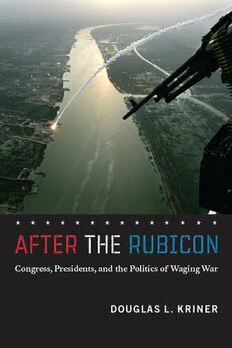
After the Rubicon: Congress, Presidents, and the Politics of Waging War PDF
Preview After the Rubicon: Congress, Presidents, and the Politics of Waging War
After the Rubicon Edited by William Howell and Jon Pevehouse After the Rubicon Congress, Presidents, and the Politics of Waging War douglas l. kriner the university of chicago press chicago and london douglas l. kriner is assistant professor of political science at Boston University and coauthor of The Casualty Gap: The Causes and Consequences of American Wartime Inequalities. The University of Chicago Press, Chicago 60637 The University of Chicago Press, Ltd., London © 2010 by The University of Chicago All rights reserved. Published 2010 Printed in the United States of America 19 18 17 16 15 14 13 12 11 10 1 2 3 4 5 isbn-13: 978-0-226-45355-2 (cloth) isbn-13: 978-0-226-45356-9 (paper) isbn-10: 0-226-45355-3 (cloth) isbn-10: 0-226-45356-1 (paper) Library of Congress Cataloging-in-Publication Data Kriner, Douglas L. After the Rubicon: Congress, presidents, and the politics of waging war / Douglas L. Kriner. p. cm. Includes bibliographical references and index. isbn-13: 978-0-226-45355-2 (cloth : alk. paper) isbn-13: 978-0-226-45356-9 (pbk. : alk. paper) isbn-10: 0-226-45355-3 (cloth : alk. paper) isbn-10: 0-226-45356-1 (pbk. : alk. paper) 1. Executive-legislative relations—United States. 2. Politics and war—United States. 3. Executive power—United States. 4. United States. Congress—Powers and duties. 5. United States—Military policy. 6. United States—History, Military. I. Title. jk585.k75 2010 355.020973—dc22 2010018918 The paper used in this publication meets the minimum requirements of the American National Standard for Information Sciences—Permanence of Paper for Printed Library Materials, ansi z39.48-1992. Contents List of Figures vii List of Tables ix Acknowledgments xi chapter 1. Introduction: Domestic Politics and Waging War 1 chapter 2. Mechanisms of Congressional Infl uence 39 chapter 3. Partisan Politics and the Initiation, Scale, and Duration of War 87 chapter 4. Congressional Actions and the Conduct of War 147 chapter 5. “Sitting Ducks”: Marines in Beirut, 1982–84 193 chapter 6. The Logic of Congressional Action 233 chapter 7. Conclusion: Congressional Constraints and the War on Terror 269 References 287 Index 315 Figures 2.1 Military policymaking at the confl ict initiation and conduct phases / 73 3.1 Frequency of U.S. major and principal uses of force, 1945–2004 / 93 3.2 Durations of U.S. major and principal uses of force, 1945–2004 / 93 3.3 Predicted effects of variables on confl ict duration in major uses of force, 1945–2004 / 106 3.4 Infl uence of divided government on confl ict duration / 119 3.5 Frequency of U.S. involvement in militarized interstate disputes, 1877–1945 / 122 3.6 Durations of U.S. involvement in militarized interstate disputes, 1877–1945 / 123 3.7 Predicted effects of variables on confl ict duration in U.S. militarized interstate disputes involving the display of force, use of force, or war, 1877–1945 / 127 3.8 Predicted effects of variables on the probability of a president responding with a principal use of force / 138 4.1 Frequency of congressional legislative actions to authorize or curtail the use of force / 153 4.2 Frequency of investigative hearings on the use of force / 159 4.3 Frequency of front-page New York Times stories reporting congressional recommendations concerning the conduct of a use of force / 165 4.4 Predicted effects of variables on confl ict duration in principal uses of force, 1945–2004 / 180 5.1 Public support for the Marine mission in Lebanon, 1982–84 / 203 viii figures 5.2 President Ronald Reagan’s approval rating, 1982–84 / 213 6.1 Predicted effects of variables on the number of binding congressional actions to curtail the use of force / 247 6.2 Predicted effects of variables on the number of congressional investigations into the use of force / 249 6.3 Predicted effects of variables on the probability of legislators voting to curtail the use of force / 264 7.1 American military casualties in Iraq, April 2007–December 2008 / 278 7.2 Percentage of Americans opposing the Iraq War, May 2007– December 2008 / 279 7.3 Percentage of Americans believing victory in Iraq still possible, April 2007–June 2008 / 280 7.4 Percentage of Americans favoring withdrawal from Iraq as soon as possible, June 2007–June 2008 / 280 Tables 2.1 Summary of hypotheses / 73 3.1 Factors infl uencing the duration of major uses of force, 1945–2004 / 102 3.2 Infl uence of congressional partisanship, before and after the Vietnam War, on the duration of major uses of force, 1945–2004 / 109 3.3 Factors infl uencing the initiation and duration of major military actions / 116 3.4 F actors infl uencing the duration of all U.S. militarized interstate disputes, 1877–1945 / 124 3.5 F actors infl uencing the duration of U.S. militarized interstate disputes involving the display of force, use of force, or war, 1877–1945 / 126 3.6 F actors infl uencing the scale and scope of major uses of force / 134 3a.1 Summary statistics for hazard models of major uses of force / 142 3a.2 Twenty post–World War II principal uses of force, with start and end dates / 143 3a.3 Selection model replicating Howell and Pevehouse equation for confl ict initiation / 144 4.1 Percentage of front-page New York Times articles on principal uses of force 1945–2004 reporting policy recommendations of various actors / 162 4.2 F actors infl uencing confl ict duration, time-varying covariates models / 171 4.3 Instrumental variable analyses of factors infl uencing confl ict duration / 186
